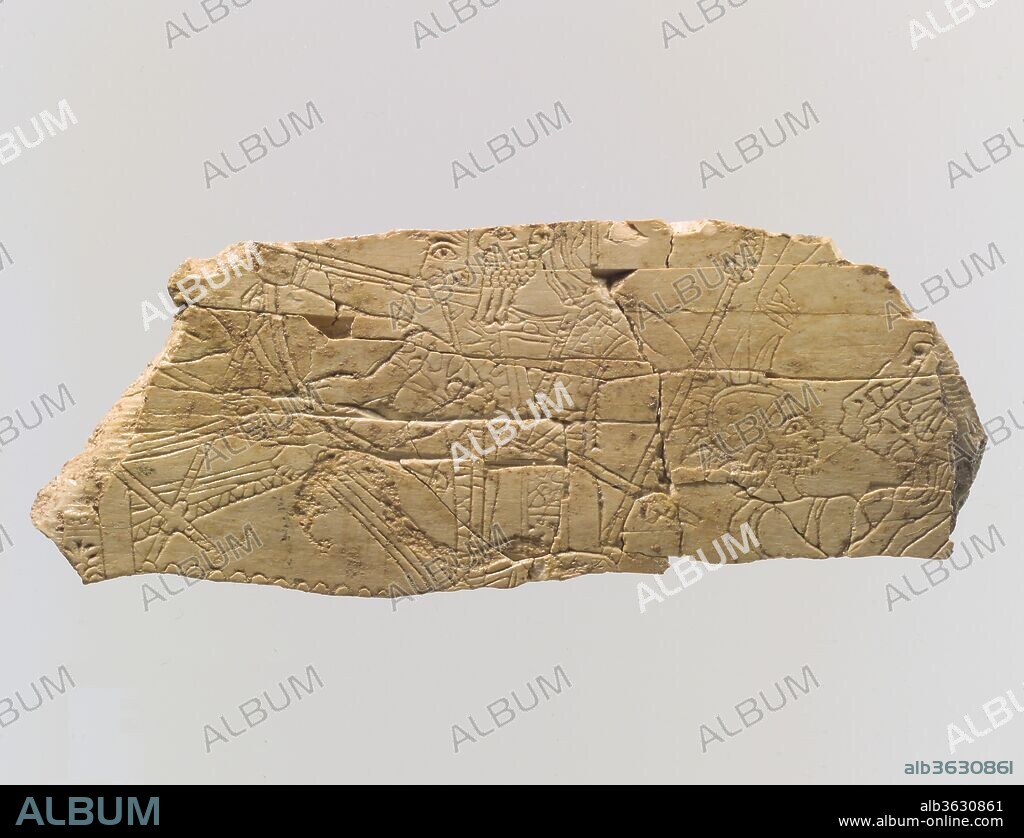alb3630861
Plaque fragment with battle scene

|
Zu einem anderen Lightbox hinzufügen |
|
Zu einem anderen Lightbox hinzufügen |



Haben Sie bereits ein Konto? Anmelden
Sie haben kein Konto? Registrieren
Dieses Bild kaufen

Titel:
Plaque fragment with battle scene
Untertitel:
Siehe automatische Übersetzung
Plaque fragment with battle scene. Culture: Assyrian. Dimensions: 1.14 x 3.03 in. (2.9 x 7.7 cm). Date: ca. 9th century B.C..
This broken piece of ivory was incised with a battle scene, now difficult to see because of the extensive damage to the piece. At center is a chariot, driven by a figure who holds the horses' reins, standing next to a bearded archer who raises his bow. Their clothing and the archer's beard identify them as Assyrians. A spear is set in the back platform of the chariot, extending diagonally away from the two soldiers in the chariot; next to the spear point, an arm dangles, probably belonging to the corpse of an enemy soldier. Below and to the right, a soldier with a short beard and an unusual helmet adorned with feathers or spikes stands before a pair of horses, his arms upraised in surrender. Carved ivory pieces such as this were widely used in the production of elite furniture during the early first millennium B.C., and were often inlaid into a wooden frame using joinery techniques and glue. Ivories carved in this style, in which scenes similar to those depicted in the stone reliefs decorating the walls of the Assyrian palaces are represented using an incised technique, are thought to have been made in Assyrian workshops for the use of the royal court. This piece was found together with other carved ivory fragments in the same style near the throne dais in the Northwest Palace of the Assyrian king Ashurnasirpal II. It was probably destroyed when the palace complexes at Nimrud were sacked during the final defeat of Assyria at the end of the seventh century B.C.
Built by the Assyrian king Ashurnasirpal II, the palaces and storerooms of Nimrud housed thousands of pieces of carved ivory. Most of the ivories served as furniture inlays or small precious objects such as boxes. While some of them were carved in the same style as the large Assyrian reliefs lining the walls of the Northwest Palace, the majority of the ivories display images and styles related to the arts of North Syria and the Phoenician city-states. Phoenician style ivories are distinguished by their use of imagery related to Egyptian art, such as sphinxes and figures wearing pharaonic crowns, and the use of elaborate carving techniques such as openwork and colored glass inlay. North Syrian style ivories tend to depict stockier figures in more dynamic compositions, carved as solid plaques with fewer added decorative elements. However, some pieces do not fit easily into any of these three styles. Most of the ivories were probably collected by the Assyrian kings as tribute from vassal states, and as booty from conquered enemies, while some may have been manufactured in workshops at Nimrud. The ivory tusks that provided the raw material for these objects were almost certainly from African elephants, imported from lands south of Egypt, although elephants did inhabit several river valleys in Syria until they were hunted to extinction by the end of the eighth century B.C.
Technik/Material:
MARFIL
Zeitraum:
NEOASIRIO
Museum:
Metropolitan Museum of Art, New York, USA
Bildnachweis:
Album / Metropolitan Museum of Art, NY
Freigaben (Releases):
Model: Nein - Eigentum: Nein
Rechtefragen?
Rechtefragen?
Bildgröße:
4170 x 3198 px | 38.2 MB
Druckgröße:
35.3 x 27.1 cm | 13.9 x 10.7 in (300 dpi)
Schlüsselwörter:
 Pinterest
Pinterest Twitter
Twitter Facebook
Facebook Link kopieren
Link kopieren Email
Email
